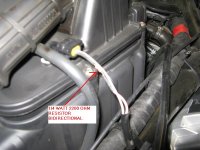For those of you interested in fixing that annoying lean backfire for your 1200 Sport (or Vintage or Norge or any Lambda probe equipped machine) here a little trick you can do to help your bike.
The science behind this is quite simple and this is commonly done on lightly modified cars. Colder air is denser and for that reason the mapping is slightly richer at colder temperatures. Airplane mechanics know this principle very well. So, we need to tell the ECU the air temperature is slightly lower.
Relevant for Guzzisties, all injected Moto Guzzies use the same air temp sensor part #30729330. Upping the resistance 2k Ohms lowers the perceived temperature signal about 20 degrees Celsius. This in turn richens up the mixture slightly. It works well on all stock bikes but this should be limited to 02 sensor bikes since earlier production year Guzzies have open loop injection systems allowing for manual mixture adjustments.
I have done this on a few 1200 Sports and it works well. Stelvios too but the difference maybe wasn't as dramatic on 8 valve machines. On most vehicles 02 sensor circuits are generally active at idle, at decel and at steady up to 1/4 throttle openings and this is where the difference is most noticeable.
Before you proceed with this little fix be aware that your bike should be tuned, throttle bodies synched and there should be no air leaks anywhere. There is no need to disconnect the idle control valve as it is quite useful on cold mornings.
Also, you are doing this for use on race tracks and not on public roads as this modification alters exhaust emissions slightly.
Lastly any modification you do to your bike is your personal responsibility that you accept at the time of deciding to modify it.
DIY:
At your local Radio Shack you can pick up a 1/4 Watt 2200 Ohm resistor for 99 cents. They come in a pack of 5, you'll need one and you can save the rest for friends overseas or across the street who end up wanting to try this.
On a Sport 1200 under the fuel tank, on top of the air box there is a connector leading to the air temperature sensor. Connector has two wires one of them is black/pink. Solder the resistor in line of that wire, make sure to insulate it with some permanent type shrink tubing. Button it up and take your bike for a ride!
Trough models this wire might change colors so do your homework before you start the work.
Greeting from Seattle and cheers!

PS: Next time I'll have better pictures, promised.
The science behind this is quite simple and this is commonly done on lightly modified cars. Colder air is denser and for that reason the mapping is slightly richer at colder temperatures. Airplane mechanics know this principle very well. So, we need to tell the ECU the air temperature is slightly lower.
Relevant for Guzzisties, all injected Moto Guzzies use the same air temp sensor part #30729330. Upping the resistance 2k Ohms lowers the perceived temperature signal about 20 degrees Celsius. This in turn richens up the mixture slightly. It works well on all stock bikes but this should be limited to 02 sensor bikes since earlier production year Guzzies have open loop injection systems allowing for manual mixture adjustments.
I have done this on a few 1200 Sports and it works well. Stelvios too but the difference maybe wasn't as dramatic on 8 valve machines. On most vehicles 02 sensor circuits are generally active at idle, at decel and at steady up to 1/4 throttle openings and this is where the difference is most noticeable.
Before you proceed with this little fix be aware that your bike should be tuned, throttle bodies synched and there should be no air leaks anywhere. There is no need to disconnect the idle control valve as it is quite useful on cold mornings.
Also, you are doing this for use on race tracks and not on public roads as this modification alters exhaust emissions slightly.
Lastly any modification you do to your bike is your personal responsibility that you accept at the time of deciding to modify it.
DIY:
At your local Radio Shack you can pick up a 1/4 Watt 2200 Ohm resistor for 99 cents. They come in a pack of 5, you'll need one and you can save the rest for friends overseas or across the street who end up wanting to try this.
On a Sport 1200 under the fuel tank, on top of the air box there is a connector leading to the air temperature sensor. Connector has two wires one of them is black/pink. Solder the resistor in line of that wire, make sure to insulate it with some permanent type shrink tubing. Button it up and take your bike for a ride!
Trough models this wire might change colors so do your homework before you start the work.
Greeting from Seattle and cheers!
PS: Next time I'll have better pictures, promised.

![hotfix 001[1].JPG](/forums/data/attachments/1/1433-1c4d1c6b15696f6ee215c4eec4965791.jpg)
